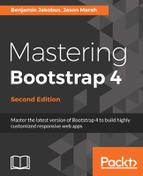The jQuery section is responsible for adding the plugin to the global jQuery object so that it is made available anywhere in an application where jQuery is available. Let's take a look at the code:
$.fn[NAME] = Alert._jQueryInterface
$.fn[NAME].Constructor = Alert
$.fn[NAME].noConflict = function () {
$.fn[NAME] = JQUERY_NO_CONFLICT
return Alert._jQueryInterface
}
The first two assignments extend jQuery's prototype with the plugin function. As Alert is created within a closure, the constructor itself is actually private. Creating the Constructor property on $.fn.alert allows it to be accessible publicly.
Then, a property of $.fn.alert called noConflict is assigned the value of Alert._jQueryInterface. The noConflict property comes into use when trying to integrate Bootstrap with other frameworks to resolve issues with two jQuery objects with the same name. If in some framework the Bootstrap Alert got overridden, we can use noConflict to access the Bootstrap Alert and assign it to a new variable:
$.fn.bsAlert = $.fn.alert.noConflict()
$.fn.alert is the framework version of Alert, but we have transferred the Bootstrap Alert to $.fn.bsAlert.
All plugins tend to follow the pattern of initial setup, class definition, data API implementation, and jQuery extension. To accompany the JavaScript, a plugin also has its own specific Sass style sheet.
